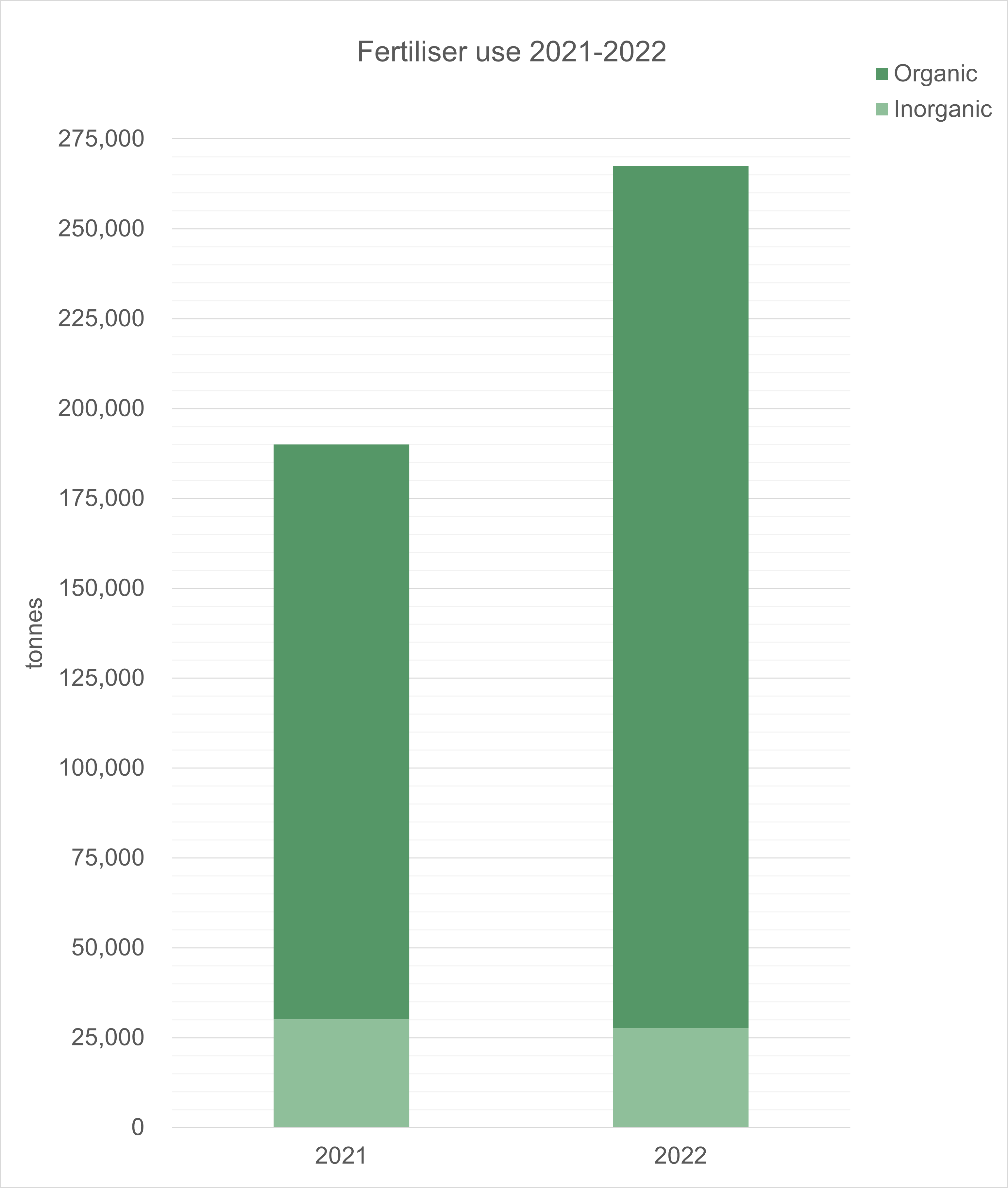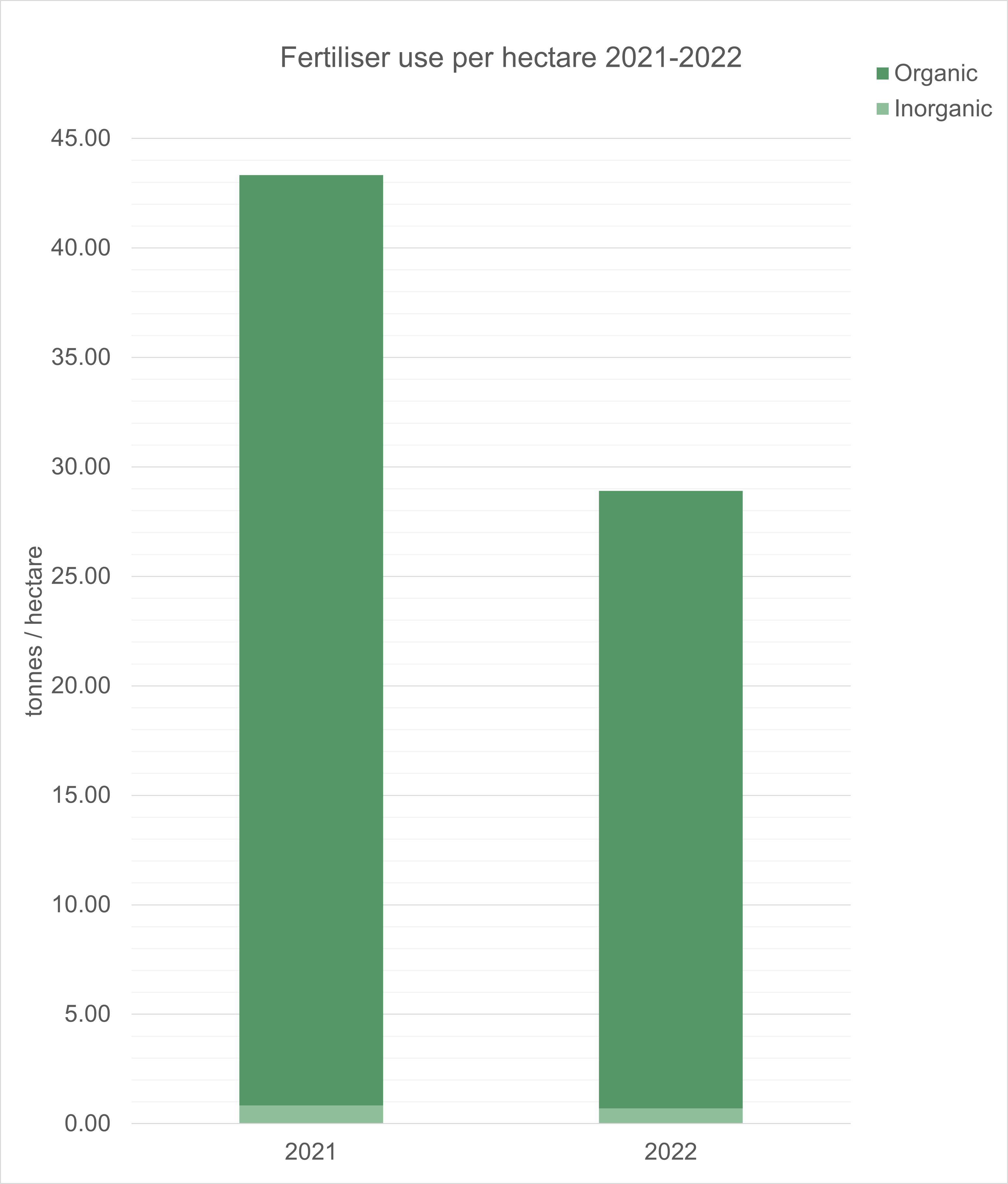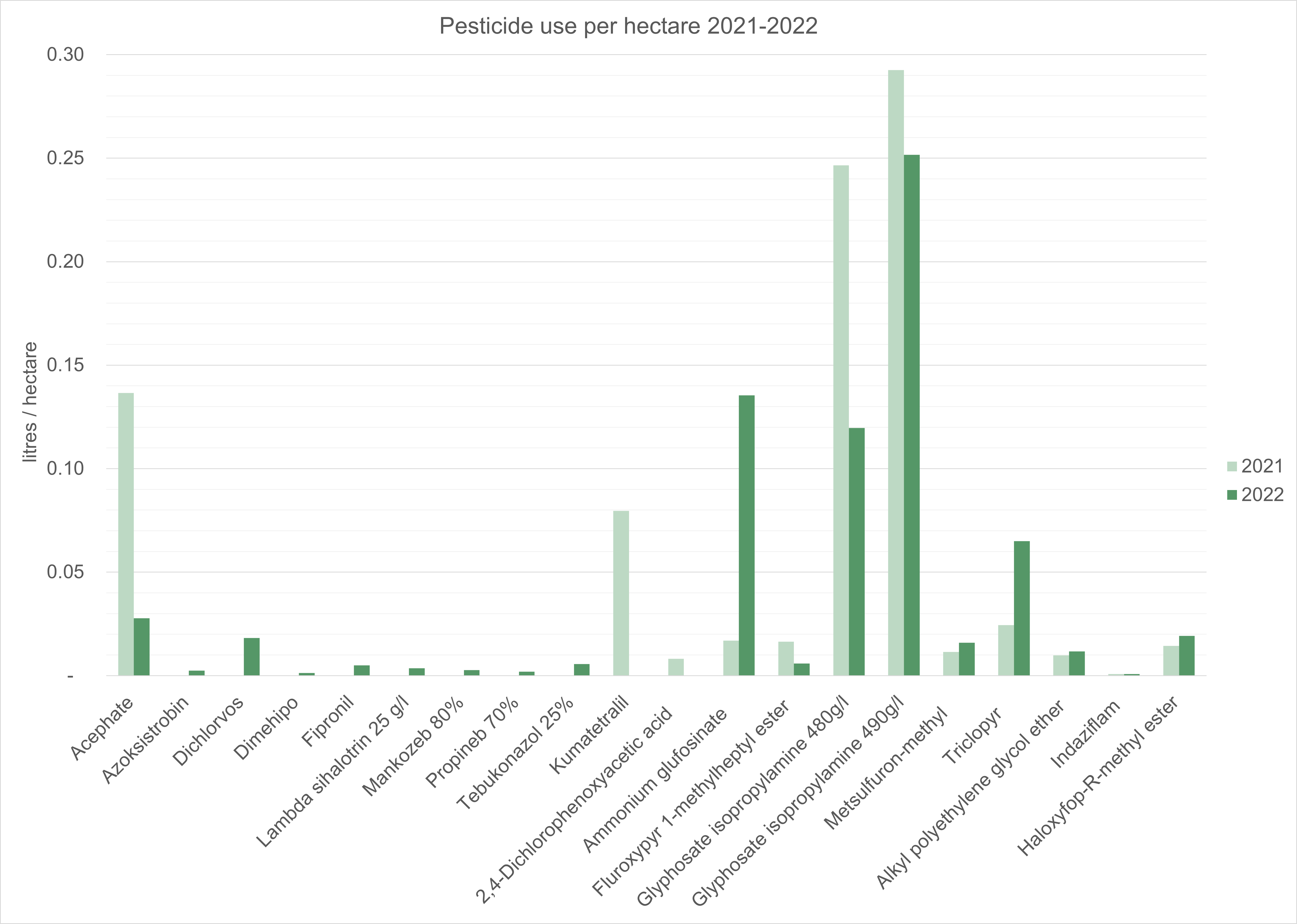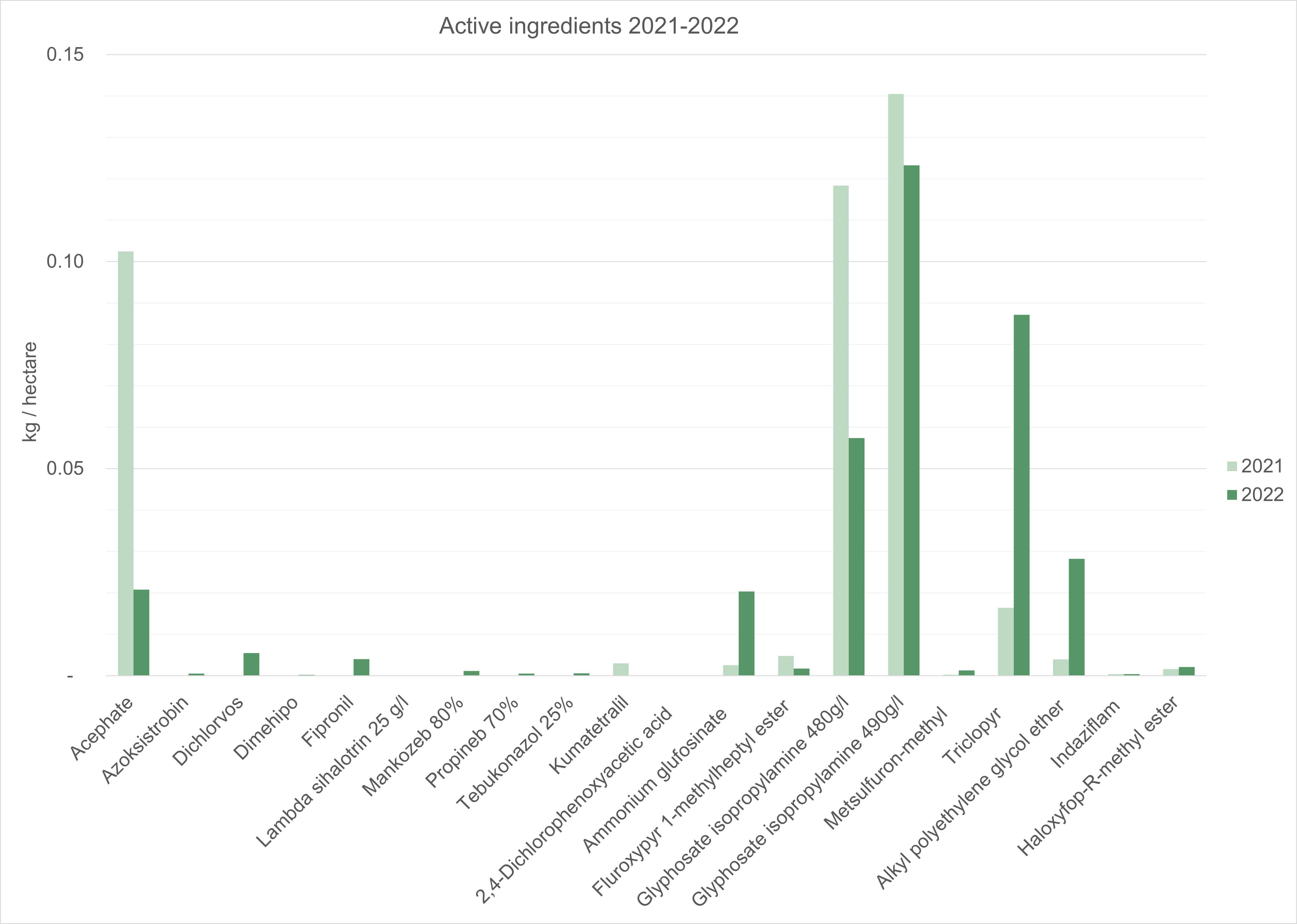FERTILISER, HERBICIDE & PESTICIDE USE
Use of fertilisers
Achieving maximum palm fruit yields with minimal cost, GHG emissions and water pollution requires careful management of our inorganic fertiliser inputs
Fertiliser application is optimised by analysing the nutrient content of systematically selected oil palm frond samples, supplemented by visual inspection of palm canopies and soil sampling. The analysis is conducted by an in-house agronomy team and verified by independent agronomy consultants. The application of inorganic fertiliser decreased between 2021 and 2022, from 32,360 tonnes (0.8 tonnes/hectare) to 24,721 tonnes (0.7 tonnes/hectare), due partly to the cessation of fertiliser applications to the mature palms that were planned for replanting (approximately 1,300 hectares or 3.7% of mature areas) from 2023 and partly to delays in deliveries of fertiliser supplies and subsequent applications as a result of heavy rainfall and flooding. 2022 fertiliser applications have been carried forward and are being applied in the first months of 2023.
The group seeks to optimise the quantity of organic and inorganic fertiliser that it applies and supplements inorganic applications with empty fruit bunches (EFB), a waste product from the mills. The application of EFB for mulching provides the palms with nutrients and the soil with organic matter which helps to retain moisture, and promote beneficial soil biodiversity and fertility. Increasing the organic carbon content of soils this way also improves their resilience to periods of dry weather which may otherwise initiate stress in the palms.


Use of pesticides
Through routine monitoring by the group’s environment department of conditions within the plantation blocks, the group seeks to identify, and potentially improve, pest management through biological control to reduce the use of chemically based pesticides.
The group’s long-established integrated pest management system aims to prevent pest outbreaks by boosting biological control. To optimise natural pest control, REA has planted species of plants known to attract natural predators of the major leaf eating pests of oil palms, including Bagworms and Nettle Caterpillars. These species (Turnera subulata, Turnera Ulmifolia, Antigonon leptopus) are planted at regular intervals along roads and on the corners of oil palm sub blocks throughout the group’s plantations. Whilst introducing barn owls is a common strategy for controlling rodents in oil palm plantations, REA has not found this to be necessary. It is thought that the population of other natural rat predators, such as leopard cats, is sufficient to control the rat population. The presence and distribution of leopard cats and other mammals is monitored by REA’s conservation team using camera traps.
When an outbreak does occur, chemical intervention may be necessary, but chemicals are only used to control pests as a last resort. REA has an early warning system in place to ensure that pests are detected and action taken before a problem escalates. The harvesting teams in each division are tasked with monitoring the oil palms for any sign of pest damage. If signs of a pest outbreak are detected, the group’s agronomy team conducts a thorough pest census immediately to identify the species involved, the scale of the outbreak and the treatment required. Wherever possible mechanical or natural means are used to halt a pest outbreak and mitigate damage to the oil palms. Since 2005, REA has only experienced a few minor pest outbreaks, all of which have been successfully controlled by targeted response commensurate with the level of the outbreak.
Where it is necessary to use chemicals to control weeds or pests, precautions are taken to protect the health and safety of employees and the environment. The medical team conducts blood and lung tests twice a year to check for chemical exposure in workers who come into regular contact with pesticides. If workers test positive for pesticide exposure, they are rotated out of spraying and into other roles. In response to growing pressure for palm oil producers to phase out Paraquat due to fears that improper handling of this herbicide may endanger the health of workers, REA ceased to use this chemical in 2013. Instead, a less hazardous glufosinate ammonium-based herbicide called Basta is used.
REA routinely monitors pesticide usage (active ingredients, litres/hectare) to evaluate the effectiveness of the application and to calculate the chemical load on the environment. For the period 2020-2021, the group used pesticides containing the following active ingredients:
- Acephate
- Azoksistrobin
- Dichlorvos
- Dimehipo
- Fipronil
- Lambda sihalotrin 25 g/l
- Mankozeb 80%
- Propineb 70%
- Tebukonazol 25%
- Kumatetralil
- 2,4-Dichlorophenoxyacetic acid
- Ammonium glufosinate
- Fluroxypyr 1-methylheptyl ester
- Glyphosate isopropylamine 480g/l
- Glyphosate isopropylamine 490g/l
- Metsulfuron-methyl
- Triclopyr
- Alkyl polyethylene glycol ether
- Indaziflam
- Haloxyfop-R-methyl ester
In 2022, the average use of pesticides (0.1 litres/hectare) remained similar to 2021, as shown below. However, there was an increase in the use of herbicides with the active ingredients glyphosate and ammonium glufosinate, and an increase in the use of adjuvants (adhesives). This was due to high rainfall at some estates, necessitating the use of more herbicides.
Compared to 2021, the intensity of pesticide use in 2022 increased by 13%. This was due to the replanting of Perdana Estate, new planting, and increased volume of insecticide and fungicide use on the immature plants and nurseries.


Soil health
Work programmes and initiatives are driven by the need to adapt and thrive in the face of challenges presented by climate change. In 2022, the group’s estates and local communities were subjected to the third consecutive year of above average rainfall brought about by the dominant La Niña weather pattern in place since 2020. If, as is projected, rainfall becomes increasingly intense during the wet seasons, infrastructure must be less flood-prone and more weather resistant. This requires investment in road-stoning, drainage and water management. If, as is also predicted, weather conditions become increasingly hot during the dry seasons, water stewardship will become increasingly challenging. The group is exploring several projects aimed at increasing the resilience of the estate soils to both absorb and store increasing amounts of water and nutrients to help buffer the projected increasing weather variability. These projects include collaborative agreements to work with researchers and commercial interests in developing methodologies for increasing the optimisation of mill waste products and other sources of organic matter and nutrients.
In furtherance of these initiatives, the group has recently signed an initial five year collaborative research agreement with SEARRP, based in Sabah, Malaysia, complementing the existing agreement with University of Cambridge signed in 2021. These agreements provide the group with access to world-renowned research networks focused on working in fragmented tropical landscapes in which oil palm cultivation plays a major role. Initial collaboration has already commenced with the group participating in survey work being carried out as part of the SEARRP SEnSOR (“Socially and Environmentally Sustainable Oil Palm Research”) programme to evaluate the effectiveness of biodiversity management and monitoring programmes. It is intended to develop a comprehensive soil health monitoring and enhancement research programme involving researchers from local universities and the SEARRP network. In addition, the group has recently submitted a joint proposal with researchers from the University of Mularwarman and BRIN (the Indonesian National Research and Innovation agency) to investigate the potential for converting organic mill by-products into biofertilisers so as to replace imported inorganic fertilisers.